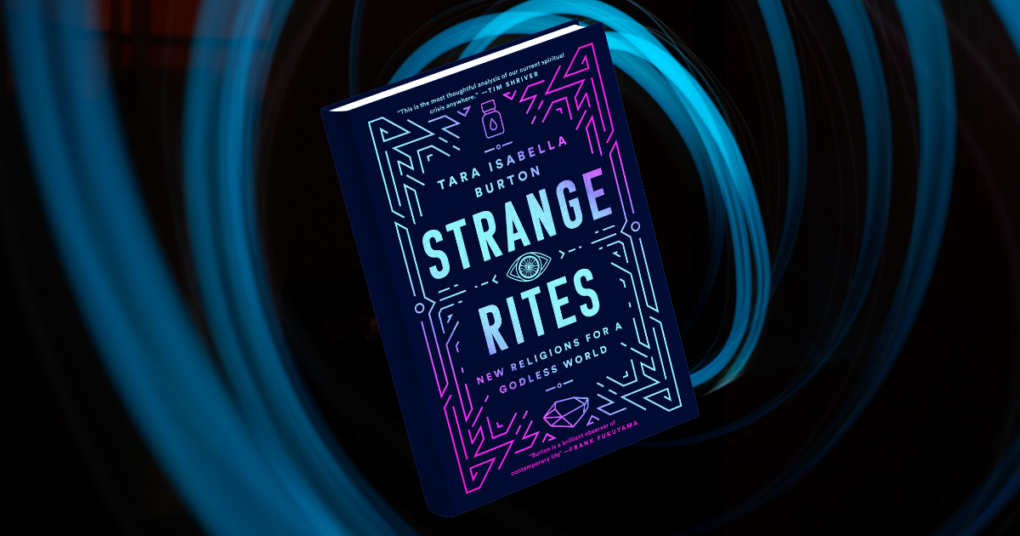Strange Rites: New Religions for a Godless World
Tara Isabella Burton
Public Affairs
2020
286 pages
Along with many other cultural commentators, I have been tracing for the past many years the phenomenon of religious disaffiliation, the sobering fact that armies of people, especially the young, are leaving institutional religion behind. It is simply no good denying the statistics, which have been borne out in study after study, and the truth of massive disaffiliation is evident to any priest, minister, or rabbi who looks out, week after week, to see ever dwindling congregations. However, I wonder whether the insistence upon the existence of so many “nones” has led to a certain misperception – namely, that all or most of those who have left the churches have simply become atheists, skeptics, and materialists. In point of fact, the closer we look at the “nones,” the stranger, more variegated, and oddly religious they seem.
My thoughts on this matter have been prompted by a remarkable book I just read called Strange Rites: New Religions for a Godless World, written by Tara Isabella Burton. Herself a millennial and in possession of a doctorate in theology, and having made her own journey through this world on her way to becoming a Christian, Burton is particularly qualified to explore the rather dense jungle of religions and spiritualities proliferating especially among those under forty. She observes that actually very few of the religiously disaffiliated would identify as atheists or strict materialists. In fact, a large number of them would fit neatly into the category of “spiritual but not religious” (SBNRs, to use the preferred acronym). Most SBNRs, though they disdain the traditional churches, remain hungry for four elements that religion has classically offered: meaning, purpose, community, and ritual. And they have found these values in some odd places.
For instance, there is, Burton shows, a vibrant community that has grown up around their common love for the Harry Potter stories, which they treat as practically sacred texts and with whose characters they deeply identify. She makes the incontestable but still startling observation: “Given that 61 percent of Americans have seen at least one Harry Potter film, it is very likely that more Americans can name the four Hogwarts houses than can name the Gospels” (p. 69). Still others find the four religious values in that farrago of beliefs and spiritual practices that goes by the name “New Age.” Think of the communities and rituals that have formed around “UFOs, Reiki, acupuncture, crystal healing, and the kind of creative visualization ubiquitous in the New Thought movement” (p. 123). Others discover meaning in their shared commitment to social justice and their concomitant disdain for those individuals and groups who stand athwart the achievement of racial, political, or gender equity. Among some radical feminists, witchcraft has taken on a tremendous spiritual significance: “Combining progressive feminist politics with a fervent opposition to institutional Christianity . . . modern witchcraft embraces its power to transgress” (p. 121).
In the course of her well-written and fascinating study, Burton gives many more examples of the sometimes wacky contemporary quasi-religions that have supplanted the traditional institutional faiths. Though it might surprise my readers a bit, this Catholic bishop would like to say something positive about all of this. The secularization hypothesis, first proposed by atheists and skeptics in the nineteenth century and reiterated ad nauseam by elite commentators today, holds that, as secularist science, technology, and education advance, religion will inevitably decline. Not only has this hypothesis been proven wrong in many parts of Asia, Africa, and Latin America, where various forms of traditional religion are booming; it has also been proven wrong in the West, where religion, despite the thousand predictions of its disappearance, continues to reassert itself. What we see in Harry Potter religion, New Age spirituality, Wicca and witchcraft, etc. are attempts to find community and purpose precisely in a ritualized relationship to some power appreciated as transcendent. We can blithely condemn all of this, or we can see it as expressive of what the Catholic tradition calls “natural religion,” which is the instinct, deeply rooted in each of us, to search for meaning in the ultimate sense. Despite the claims of the ideological secularists, it is just not that easy to stamp out religion. In the face of obstacles both exterior and interior, it finds a way.
Now, this does not mean for a moment that Christians should be satisfied with the “blooming, buzzing confusion” of natural religion, especially the kinds on offer today, but we should, as St Paul, St Irenaeus, St Augustine, St Thomas Aquinas, G.K. Chesterton, and Pope Benedict XVI did in their own day, meet it and engage it with the word of revelation. One of the marks of the natural religious attitude is that the seekers are always in control of the conversation: they set out to find ultimate meaning on their own terms. Burton in fact argues that this tendency is especially prevalent today, when seekers claim the right to rewrite sacred texts and reconfigure sacred rituals to suit their personal preferences. But a revealed religion, like Catholic Christianity, holds that God has spoken. Our quest is real and it can be holy, but what finally matters is that God has answered it on his terms.
Again, it would be easy enough to write off the frankly weird forms of religiosity that Burton describes, but this would be seeing glass as half-empty. Rather, we Catholics should rejoice that the religious instinct remains vibrantly alive in the SBNR’s. And then we should eagerly engage that instinct with the liberating challenge of the Gospel.
About the Author: Bishop Robert Barron
This article first appeared at: www.wordonfire.org. Bishop Robert Barron is an author, speaker, theologian, and founder of Word on Fire, a global media ministry. This article has been reprinted with the kind permission of the editors.

